To my mind, Judy Roderick was one of the finest blues/acoustic folk singers of her time. From her LP of the same title, released in 1965, this song has been recorded by many artists since, including The Grateful Dead, usually as “I Know You Rider.”
October 2020
Tue 13 Oct 2020
Music I’m Listening To: JUDY RODERICK “Woman Blue.”
Posted by Steve under Music I'm Listening ToNo Comments
Mon 12 Oct 2020
A TV Episode Review by Jonathan Lewis: THE FUGITIVE “The Other Side of the Mountain†(1963).
Posted by Steve under Reviews , TV Drama[14] Comments
THE FUGITIVE “The Other Side of the Mountain.†ABC, 01 October 1963 (Season 1, Episode 3). David Janssen. Guest Cast: Sandy Dennis, Frank Sutton, Ruth White. R.G. Armstrong, Barry Morse, Bruce Dern. Narrator: William Conrad. Screenwriters: Alan Caillou & Harry Kronman. Director: James Sheldon.

A few nights ago, I watched “The Other Side of the Mountain,†a season one episode of The Fugitive. In this episode, Richard Kimble aka The Fugitive (David Janssen) runs afoul of the local authorities in a dying West Virginia coal mining town. The sheriff is portrayed by R.G. Armstrong, while his deputy is played by a youthful Bruce Dern who, as of the time, had not yet appeared on the big screen. The episode is a fairly strong one, bolstered by the presence of stage actress Sandy Dennis, who plays a local girl who provides sanctuary to Kimble. She also, not surprisingly, falls in love with him and all but begs him to take her with him.
I enjoyed the episode quite a bit. Seeing Dern as a smarmy lawman eager to pick a fight with Kimble was something else. Dern, unlike Armstrong, Dennis, and two others, was not given guest star status. He really was a supporting TV character looking for bit parts at the time.

Fast forward six years. Or, in my case, one day. And I sit down for an episode of Lancer (“A Person Unknownâ€), the CBS oater recently brought back into public consciousness for its “appearance†in Quentin Tarantino’s Once Upon a Time in Hollywood (2019). In this episode, Johnny Madrid Lancer (James Stacy) runs afoul of a powerful man and his son. He not only is wounded in a fight. But is falsely accused of murdering his Mexican friend. A crime he did not commit. As it turns out, the injured Johnny has to hide out in an out of the way farmhouse in which he is provided succor by a young girl (Quentin Dean in her final acting role). Sound somewhat familiar?

One more thing you should know. The person hot on his trail, the very same person who is the real murderer is portrayed by none other than Bruce Dern. One could not help but compared Dern’s performance in the 1963 episode of The Fugitive with that from this Lancer episode from 1969. Dern had, by this point, definitely come into his own as an actor. Here he had all but perfected the sneering, quasi-psychotic villainy that was so disturbingly effective in The Cycle Savages (1969) which I reviewed here.
His scenes with Quentin Dean, who had appeared with Charlton Heston in Tom Gries’s excellent Will Penny (1967) which I reviewed here are just as effective as his first scene in which he taunts Johnny’s Mexican friend before killing him. All told, it’s a solid episode from a Western TV series that did not last very long, but benefited immensely from having some of the best character actors from its era as guest stars.
NOTE: Dern makes his first appearance in the video above at roughly the 7:00 mark.
Mon 12 Oct 2020
A PI Mystery Review: JON MESSMANN – A Bullet for the Bride.
Posted by Steve under Reviews[2] Comments
JON MESSMANN – A Bullet for the Bride. Ed Steel #1. Pyramid N2792, paperback original, September 1972.
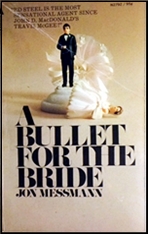
Once again what we have here is a PI hero who doesn’t have a PI license, but that doesn’t make him any less of a PI, does it? When he’s approached by a would-be client and after hearing her story, tells her to go find a private eye, guess what? That’s when we know that he really is one. She needs him to investigate the woman who’s gotten herself engaged to her father – one of the richest men in the world – and she doesn’t think she’s on the level.
To back up a little, Steel is retired, lives in Miami on a boat, but a fellow named Byron Ryberg, who was his boss during the Korean War when they both worked for the CIA, still sends jobs his way, such as this one. Ryberg is concerned that the girl is right, and if she is, and maybe if she’s working for the wrong hands, maybe the good guys would like to know about it – given that, as I said, the father is one of the richest men in the world.
On the downside of this story is that Steel is one of those men who, when they meet a woman for the first time, measures their worth by gauging the size and bounce of their chest. On the other hand, he’s a whiz at running a boat, which comes in very very handy several times during the course of this book.
Which is a case of Travis McGee (as you may have already noted yourself) meets James Bond. The stakes are, as it so happens, a whole lot higher than in any of the McGee books, but yet Steel has nowhere near the innate suaveness of Mr Bond. The book consists of long periods of introspection and talkiness, punctuated by short bursts of violence. He does bed the lady, but thankfully without going into details.
The ending strongly hints at a followup adventure, but it never happened. Messmann did go on write six book in his Jefferson Boone, Handyman, series, and 15 books in the Nick Carter series. His largest claim to fame, perhaps, is writing most of the first 200 books in the adult western series, The Trailsman, as Jon Sharpe.
Sun 11 Oct 2020
PI Stories I’m Reading: CAROLINA GARCIA-AGUILERA “The Right Profile.â€
Posted by Steve under Stories I'm Reading[4] Comments
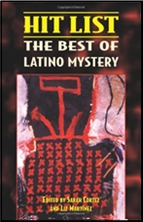
CAROLINA GARCIA-AGUILERA “The Right Profile.†Short story. Maria Magdalena “Maggie” Morales #1. First published in Hit List: The Best of Latino Mystery, edited by Sarah Cortez & Liz MartÃnez (Arte Público Press, 2009). Probably never reprinted or collected.
As a Cuban-American private eye based in Miami, Maggie Morales seems to work exclusively for a low level attorney named Bobbie O’Meara. (She tries to get paid in advance but doesn’t always succeed.) In this case, her only appearance on record, her assignment to get the goods on an ex-husband who claims he can’t pay the money he owes to his former wife because he can’t work. He’s a photographer by trade, and in court, he’s an awfully good faker.
Posing as a client who needs a photo shoot done, Maggie gets the evidence that proves otherwise, with a final shot back at the man in court that he richly deserves. It’s a minor case, but even so, it provides the reader a solid ten minutes of reading fun. The author, Carolina Garcia-Aguilera, a PI herself, is better known for the six novels she has written about another Cuban-American private eye by the name of Lupe Solano, also based in Miami.
Sun 11 Oct 2020
A Movie Review by David Vineyard: DUFFY (1968).
Posted by Steve under Crime Films , Films: Comedy/Musicals , Reviews[17] Comments
DUFFY. (Columbia Pictures, 1968. James Coburn, James Mason, James Fox, Susannah York, John Alderton. Screenplay: Donald Cammell and Harry Joe Brown Jr., both of whom are credited with the story along with Pierre La Salle. Directed by Robert Parrish.
Nothing ages worse than old hipster unless it is old hipster comedy, dripping with pretension as only hipsters could drip pretension, and imagining mostly overage pre-hippy/Eurotrash types planning a big caper.
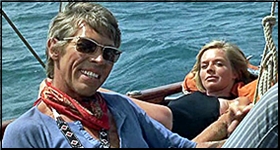
Luckily for everyone involved this one has James Coburn and Susannah York (“I may be a hooker, but I am absolutely not a slut.â€) to deliver actual cool and real sensuality to what would be without them as painful to watch as John Alderton’s rather thick English twit performance here.
Coburn is Duffy, a former con man and smuggler recruited by half brothers Stefane and Antony (James Fox and John Alderton) and Stefane’s girl Segolene’s (York) plot to play pirate robbing the ship the Osiris out of Tangiers carrying a fortune belonging to their cynical and cruel father J. C. Calvert (James Mason).
It would help if Mason’s character was at least nasty. As is his greatest sin seems to be rightly thinking his sons are useless and a dunce, and he isn’t far off.
And I would point out that since this is an English film with English characters it would help if the characters weren’t given silly names like Stefane, Antony, and Segolene with no explanation.
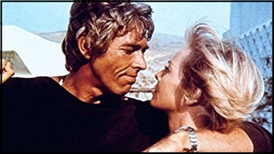
The boys remember Duffy who was a mate on their father’s yacht when Stefane and Segolene come up with the idea and convince the retired crook to go into the caper with them despite his reservations. While they stay in Tangier at Duffy’s place (decorated in porn chic for lack of any other description to fit the absolutely tasteless decor), York and Duffy become involved as the time for the shipment grows closer and their plans go into effect.
Among the better things about this are the location shooting and gorgeous cinematography, if only someone had told Cammell and Brown (whose career is as spotty as Cammell’s) they weren’t actually the least bit hip, and Parrish had not let himself be convinced they were this might have been a pretty good caper film, but as it is the heist itself is anti-climactic and boring.
As it stands everyone is too old and stuck with terrible dialogue:
“I hope Stefane is okay. I hope Stephane hopes I’m okay.â€
“It has occurred to me I’m getting used to you finally, and I probably love you in the worst possible way, I guess.â€
It’s no “We’ll always have Paris.â€
Cammell did somewhat better with his own film Performance (still pretentious, but interesting) and Demon Seed (which he hated and tried to make into a comedy), but basically this film is as problematic as his career. Even Coburn stumbles over some of the dialogue that sounds as if it was written as a Mad Magazine parody of Jack Kerouac.
But Coburn can’t help but be Coburn and even here is ultra cool, while York is incredibly sexy despite it all, those icy eyes fascinating, though she and Coburn both scored better in the altogether more satisfying Sky Riders.
James Mason is James Mason no matter what he is in, and that is always a bonus.
There is a twist if you make it that long, but it really isn’t enough to lift this above the level of interesting. And honestly, if you didn’t guess the twist from the start, you weren’t paying attention.
But I will give it that the end and Coburn being Coburn plus Lou Rawls singing “I’m Satisfied†end it better than the rest of the movie deserves.
Arguably this might have been better seen in a theater in 1968 when I was 18, but I don’t think so. I didn’t take drugs then either, and only that could help this.
What a huge waste of talent and beautiful scenery.
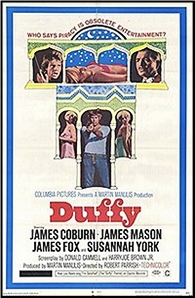
Sun 11 Oct 2020
Music I’m Listening To: SALLY BARKER “Money’s Talking.”
Posted by Steve under Music I'm Listening ToNo Comments
A song I think we can all identify with:
Sat 10 Oct 2020
RED EYE. DreamWorks, 2005. Rachel McAdams, Cillian Murphy, Brian Cox, Jayma Mays. Director: Wes Craven.

This is first and foremost a Wes Craven movie. It’s beautifully photographed, the shots are well taken, the music is well-chosen and perfectly timed, and he’ll almost have you believing the story, too.
Which has to do with a gang of terrorists forcing a young female hotel manager to make sure their target in is the right room at the right time. I hate to tell you more about the story than I knew when I started watching the movie, but suffice it to say that she is on an overnight flight back to town, and their means of coercion has to do with her father. Watch the clip below:
Cillian Murphy is the coercive factor, charming at first when the two meet “accidentally” at the airport, but turning into the evil twin brother of Illya Kuryakin, once they are on the plane, in the air, and he in the seat next to her.
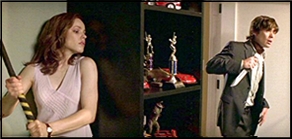
She’s trapped in the air with him. Once he tells her what he needs to have her do, what can she do? Enough to fill 60 minutes of flight time, more or less, he the cat, she the mouse. But she’s resourceful to just barely keep the PG rating for this movie.
Once off the plane, the action is nearly non-stop, leaving the viewer little time to wonder about small little details, not until the movie’s over. If you had as much fun as I did along the way, you may not care. Otherwise all bets are off.
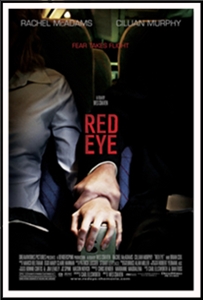
Fri 9 Oct 2020
Reviewed by Ray O’Leary: MARTIN H. GREENBERG, Editor – The Further Adventures of Batman.
Posted by Steve under Comic Books, Cartoons, Comic Strips , Reviews[6] Comments

MARTIN H. GREENBERG, Editor – The Further Adventures of Batman. Bantam, paperback original, 1989.
In connection with all the recent Batman hype, someone had the bright (and, I think, interesting) idea of having various writers of genre fiction try their hands at writing a Batman adventure. For the most part, alas, the Batman comes across as little more than a Comic Book character.
This collection of fourteen stories by fifteen authors opens with Robert Sheckley’ s “Death of a Dreammaster,” which peters out after a promising premise. It’s followed by the two best stories in the book: Henry Slesar’s “Bats,” in which Batman has seemingly gone crazy, and Joe R. Lansdale’s “Subway Jack,” about a serial killer murdering bag ladies on the subway.
Unfortunately, the rest of the stories, except for occasional high spots in Mike Resnick’s “Neutral Ground†and Edward Wellen’s Riddler story “Wise Men of Gotham†are pretty much ho-hum at best.
Contents:
1 • Death of the Dreammaster • novella by Robert Sheckley
69 • Bats • novelette by Henry Slesar
101 • Subway Jack • novelette by Joe R. Lansdale
139 • The Sound of One Hand Clapping • short story by Max Allan Collins
159 • Neutral Ground • short story by Mike Resnick
165 • Batman in Nighttown • novelette by Karen Haber and Robert Silverberg
191 • The Batman Memos • short story by Stuart M. Kaminsky
207 • Wise Men of Gotham • • novelette by Edward Wellen
247 • Northwestward • [Black Widowers] short story by Isaac Asimov
267 • Daddy’s Girl • short story by William F. Nolan
285 • Command Performance • novella by Howard Goldsmith
343 • The Pirate of Millionaires’ Cove • short story by Edward D. Hoch
363 • The Origin of the Polarizer • novelette by George Alec Effinger
393 • Idol • short story by Ed Gorman
Thu 8 Oct 2020
A British TV Episode Review: NEW TRICKS “The Chinese Job†(2003).
Posted by Steve under Reviews , TV mysteries[12] Comments
NEW TRICKS “The Chinese Job.†BBC, 23 March 2003. 90m. Amanda Redman, James Bolam, Alun Armstrong, Dennis Waterman. Guest Cast: Jon Finch, Jill Baker. Created by Roy Mitchell and Nigel McCrery. Screenplay by Roy Mitchell. Director: Graham Theakston.
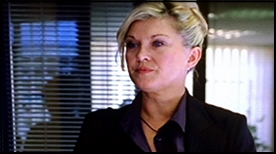
“The Chinese Job†was the pilot for this long-running TV program, being shown one year before the series began. It was on for 12 seasons, with most if not all of the original cast having moved on before it finished. I think the basic premise, one that even younger viewers could relate to, is one that suggests that older people need not be put out to pasture, so to speak, even though they’ve retired. And, even more, and simply put, they can learn new tricks.
It begins at first as mostly a public relations gimmick, but the Unsolved Crime and Open Case Squad (or UCOS for short), a division within London’s Metropolitan Police Service tasked with re-investigating unsolved crimes. Headed by a fully active superintendent slash supervisor, three ex-detectives are brought in, as civilians to begin working on such cases. To wit (copying and pasting liberally from Wikipedia):

Detective Superintendent Sandra Pullman (Amanda Redman) (2003–2013): Sandra is the head of the unit. She was an up-and-coming officer in Greater London’s Metropolitan Police Service until the shooting of a dog during a hostage rescue, which is a running joke during the early series. Her career consequently stalled and she is made to take charge of UCOS, initially against her will.
John ‘Jack’ Halford (Ex-Detective Chief Superintendent) (James Bolam) (2003–2012, 2013): The highest-ranking retired officer on the team, and the first to be approached by Sandra when setting up UCOS, Jack Halford is the unofficial second-in-command. He is Sandra’s mentor on numerous occasions, having been her boss on the murder squad.
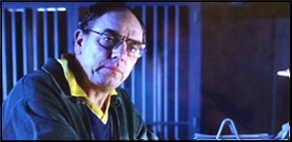
Brian Lane (Ex-Detective Inspector) (Alun Armstrong) (2003–2013): Brian ‘Memory’ Lane is an exceptional detective, possessing a keen attention to detail and a remarkable instant recall memory for obscure details regarding cases and officers who investigated them. Brian is socially inept and eccentric, a recovering alcoholic with obsessive-compulsive personality disorder.
Gerry Standing (Ex-Detective Sergeant) (Dennis Waterman) (2003–2015): He is nicknamed “Last Man Standing”, because of his refusal to take backhanders (bribes) when his squad were paid off by a gangster. A ‘Jack the lad’, Gerry is an old-school police officer. He was a ‘thief-taker’, who passionately enjoyed catching criminals, but nevertheless mixed easily with them, leading to allegations of corruption. Although he always denied this, he quit before he could be disciplined.
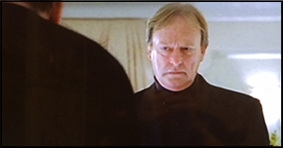
The case they first get their teeth into is that of a mob boss (Jon Finch) who’s already served twenty years for killing a young girl, but who has now been freed on a technicality. UCOS’s charge: find additional, untainted evidence that he really did do it. The problem: the more they investigate, the more apparent it seems that he did not do it. That he was framed, and worse, by the chief investigator in charge at the time.
I’m not sure how it happened this way, but I’d already watched seasons three, four and five, before I got back to this one, but in a way, I’m glad I did. It was quite fascinating to see the contrast, but looking backward, not forward. How it was when the squad began, when most of them did not know each other, nor their various strengths and weaknesses, and above all, their foibles – and how to get along together. In all likelihood, the writers for the show did not know exactly where they were going, either, not where they would be two or three seasons yet to come.
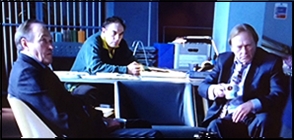
In this the pilot episode, quite a bit of it has to do with how these three retired gents learn what new toys – computers, DNA sampling and the like – they now have at their disposal, while they continue with their old ways of bending rules when they need to to get the results they want – while not really breaking them. All the while Sandra, their nominal boss, finds out very quickly that herding cats is not the easiest job in the world.
By the time I started watching the series, the Squad was working like a well-oiled machine. Here in the pilot they were still working the kinks out, and I enjoyed watching it happen.
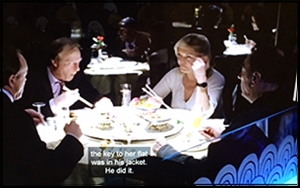
Wed 7 Oct 2020
REVIEWED BY DAN STUMPF:
W. R. BURNETT – High Sierra. Alfred A. Knopf, hardcover, 1940. Paperback reprints include: Bantam #826, 1950; Carroll & Graf, December 1986; Zebra, November 1987.
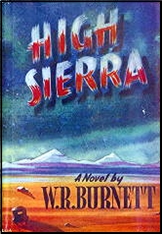
Films: Film: First National, 1941 (with Ida Lupino, Humphrey Bogart; director: Raoul Walsh). Also: Warner Bros., 1949, as Colorado Territory (with Joel McCrea, Virginia Mayo; director: Raoul Walsh). Also: Warner Bros., 1955, as I Died a Thousand Times (with Jack Palance, Shelley Winters; director: Stuart Heisler).
Have been reading W. R. Burnett. Two westerns, The Dark Command and Adobe Walls are well done, if nowhere close to his magnificent Saint Johnson, and I also picked up High Sierra, which really moves.
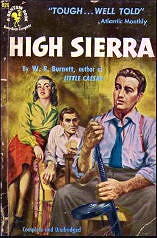
With a book as perfect of its type as this one, there just ain’t much you can say: tightly written, unsentimental (unlike the movie made of it) and completely uncompromising, it flows so smoothly from start to finish, one can only sit back and enjoy. Which I recommend you do.
I might add that it was filmed in 1941 by Raoul Walsh at Warners, one of the Essential Bogart Flicks, with a richly 40’s cast, including Ida Lupino, Henry Hull, Arthur Kennedy and Cornell Wilde – and a little too much schmaltz. Much better is Walsh’s 1949 Western remake, Colorado Territory, with Joel McCrae and Virginia Mayo.
And finally it was remade once more as an overheated contemporary caper film with Jack lance, Shelley Winters, Lee Marvin and Earl Holliman as Defiant Young Punks made up to look like Lenny and Squiggy.